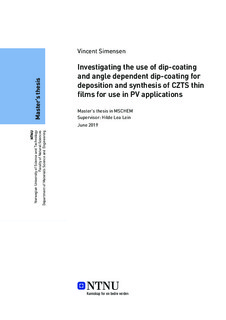| dc.description.abstract | CZTS thin films were synthesized, with fluorine doped tin oxide (FTO) on soda-lime glass (SLG) as a substrate, by means of dip-coating and angle dependent dip-coating. The experimental procedure involved using thiourea as a solution-based sulfur source for the formation of CZTS and deposited samples were annealed at 500 C in argon atmosphere for different annealing times. The effect of withdrawal speed and annealing time was investigated for conventional dip-coating, while the effect of dip angle as well as annealing time was investigated for angle dependent dip-coating. Characterization of thin films was performed with Raman spectroscopy, X-ray diffraction, ultraviolet-visual spectroscopy, scanning electron microscopy (SEM) imaging, as well as electron dispersive X-ray spectroscopy (EDXS). The thickness of the depositions were found to increase with increased withdrawal speed and the film quality was highly dependent on the annealing time. The samples produced from conventional dip-coating reached a maximum thickness of around 790 nm after two depositions annealed 12 h for each layer, and showed an even distribution of elements but a noticeable surface porosity. The film had a estimated bandgap value of 1.31 eV, with sodium present in the sample which was believed to have been a result of diffusion from the SLG layer and the possible presence of ZnS in the bulk structure. The samples produced from angle dependent dip-coating reached a maximum thickness of around 900 nm after two depositions annealed 0.5 h for the first layer and 6 h for the second layer. The result was a compact surface with little to no crystallites on the surface, believed to have been Cu2SnS3 phases. The film has an estimated bandgap value of 1.52 eV and even distributions of elements with a small amount of sodium present. ZnS phases in the bulk structure were still a possibility. The experimental procedure involving the use of angle dependent dip-coating was deemed a success, considering this being the first work known to the author that employs said method for CZTS thin film synthesis. | |
